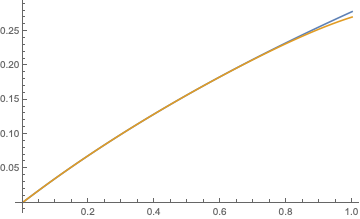Consider the equation
$$y=x e^x.$$ Its real solution is given by $$x=W(y),$$ where $W$ is the Lambert W function (or product log).
Can the function
$$f(x) = W\left(-\frac{1}{r}xe^x\right)$$
be written in simple terms of $x$?
What I've tries so for is writing this as a power series expansion
$$W(x)=\sum_{n=1}^{\infty}\frac{(-1)^n n^{n-2}}{(n-1)!}x^n$$
therefore with the constant I've introduced $$ \begin{split} W\left(-\frac{1}{r}x\right) & =\sum_{n=1}^{\infty}\frac{(-1)^{n-1} n^{n-2}}{(n-1)!}\left(-\frac{x}{r}\right)^n\\ & =\sum_{n=1}^{\infty}-\frac{(-1)^{n-1}(-1)^{n-1} n^{n-2}}{(n-1)!}\left(\frac{x}{r}\right)^n \\ & =\sum_{n=1}^{\infty}-\frac{n^{n-2}}{(n-1)!}\left(\frac{x}{r}\right)^n \end{split} $$ but got stuck here.
I've also tried guessing many functions in mathematica that yeilded no result.
As I see it now the problem is not solvable



